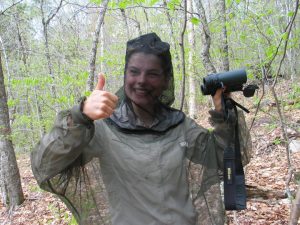Research Highlights: Does acid rain affect the seasonal changes of forest trees?
By Erin Redding
 The Bear Brook Watershed in Maine (BBWM) is a “paired watershed” study designed to compare the effects of atmospheric deposition and climate change on forest ecosystems. In order to mimic the acid rain experienced in some areas of the United States, the west watershed has been treated by adding the chemical ammonium sulfate, which is similar to the sulfur compounds in acid rain….[explain] every two months since November 1989. The east watershed has been left as an untreated reference. This is one of the few long-term studies of its kind in the world and has informed many other studies of acidification, nitrogen enrichment, and climate change in forests.
The Bear Brook Watershed in Maine (BBWM) is a “paired watershed” study designed to compare the effects of atmospheric deposition and climate change on forest ecosystems. In order to mimic the acid rain experienced in some areas of the United States, the west watershed has been treated by adding the chemical ammonium sulfate, which is similar to the sulfur compounds in acid rain….[explain] every two months since November 1989. The east watershed has been left as an untreated reference. This is one of the few long-term studies of its kind in the world and has informed many other studies of acidification, nitrogen enrichment, and climate change in forests.
The goal of my research is to discover whether or not 20+ years of acid treatment have caused a measurable phenological difference between the canopy trees of the two watersheds. A phenological difference is a distinction between the timing of a biological event. I followed the phenophases (seasonal changes) of 30 canopy trees in each watershed. spring bud burst, leaf out, leaf color change, and leaf drop in red and sugar maples; and bud burst, needle unfolding, and lengthening in spruce trees. This was challenging work. It was difficult to observe canopy trees from the forest floor; the view was often blocked by understory plants and self-shading in the canopy. I was unable to observe all of my sample trees every day, due to the travel time to the remote site, and the distance between trees in the mountainous watersheds, so in some cases, phenophase dates are more general than I would have preferred. Automated data collectors, webcams, and a continuous on-site staff would benefit this type of monitoring and environmental research.
I also looked at the chemical phenology of the canopy trees. Chemical phenology refers to the change in nutrient levels in a plant throughout the year. It is different than traditional phenology because humans cannot see the changes. Approximately once a month, beginning in May 2010, I sampled foliage from 30 trees (five trees per species per watershed). After rinsing, drying, and grinding the foliage samples, I analyzed the ground tissue for nutrient content. The results of this analysis will tell us if the trees in the treated watershed are experiencing foliar chemistry changes at different times than the trees of the reference watershed, and how that might relate to physiological phenology observed. For example, do higher nitrogen levels in the treated maple trees cause the leaves to stay on longer?
So far, we have found a quantitative difference between the nutrients in west and east watershed, but we still need to determine if the difference is also temporal. This study has highlighted ways to improve existing protocols for forest phenology research. These findings should prove useful to phenology researchers at the Bear Brook Watershed in Maine and elsewhere.

